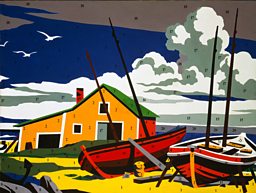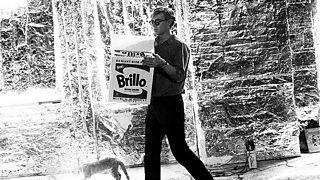Transmitting Warhol
12 August 2015
Twenty-seven years since his death, the ideas Andy Warhol filtered through his work have now become so prevalent as to be almost invisible. He took the mass market – Campbell's soup cans and Brillo pad boxes – and made them into his fine art, which itself became mass market.

Warhol's concept of 15 minutes of fame (for which photographer Nat Finkelstein also claims authorship) is now seen to be so mundanely true as to be barely worth mentioning. But what unifies many of his ideas is that they are endlessly fascinating reflections on modern life.
Warhol voraciously mirrored the world around him – its stars, its horrors, its gaudy creations, often deploying the easiest or cheapest of means to do so: screen prints, photographs, illustrations, magazines, film, video.
Tate Liverpool's exhibition in late 2014, Transmitting Andy Warhol, was a timely reminder of the breadth of the pop artist's remarkable output and how Warhol exploited all the means of expression open to him.
Curator Darren Pih showed BBC Arts around the exhibition. As Warhol was often wont to say: "Wow!"
The original version of this article was published in November 2014, to accompany the opening of the exhibition.

Warhol Links
Pop Art Features
-
![]()
The Politics of Pop Art
A dissenting view from the global artists represented at The World Goes Pop exhibition at Tate Modern.
-
![]()
Pop Art's Road Trip
Alastair Sooke on the stark, understated gas station photographs of Ed Ruscha.
-
![]()
Did Scottish artists invent Pop?
Can Pop Art really trace its origins to the work of a couple of artists from Scotland?
-
![]()
Sun Kings
Stephen Smith compares the courts of Andy Warhol and the original Sun King, Louis XIV - with the Factory as a 1960s Versailles.
-
![]()
Pop Idents by Pop Icons
Watch the BBC Four Goes Pop! channel idents by Peter Blake, Derek Boshier & Peter Phillips.
-
![]()
What's Andy Doing Right Now?
Find yourself in the midst of a typical day for Pop Artist Andy Warhol in the mid-1960s.
-
![]()
Warhol's Polaroids
The genius behind the camera that enabled Andy's instant celebrity obsession.
-
![]()
The Power of Desire
Controversial British Pop Artist Allen Jones is the guide around his Royal Academy exhibition.
-
![]()
Dividing Opinion
A Career in Quotes: What the critics said about controversial British Pop Artist Allen Jones.
-
![]()
24 Hours with Andy Warhol
Follow Andy and his entourage as they tour London in 1970, meeting David Hockney and film critic Dilys Powell.
-
![]()
Cheese!
A fascinating look inside The Factory in 1965, as filmmaker and activist Susan Sontag visits while Andy is filming.
-
![]()
Cover Star
When Everyone Could Own a Warhol: Andy Warhol's 1950s album covers for hip jazz labels such as Blue Note.
-
![]()
Superstars & Silver
The Factory 1964-1970: Billy Name's iconic images of Warhol's Silver Factory, with the Velvets, Nico, Warhol superstars & Dali.
-
![]()
Heroes of German Pop
William Cook on the exquisite colours of German Pop at an exhibition in Frankfurt.
-
![]()
German Pop: In pictures
Artworks from the bold and brilliant pioneers who shaped Germany's 1960s pop art scene.
-
![]()
Transmitting Warhol
A video tour of last year's Andy Warhol exhibition at Tate Liverpool.


















